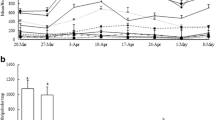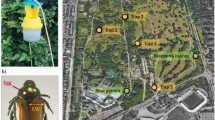Abstract
The response of Trichogramma spp. egg parasitoids to colored sticky traps was evaluated in the field during two seasons (1995/1996, 1996/1997). Traps consisted of a glass tube coated with Bird-Tanglefoot® into which colored paper was inserted or clear traps without paper. Colors tested were white, green, blue, yellow and red in the first season and white, green, yellow and black in the second season. The proportion of both female and male parasitoids caught on the sticky traps was significantly different among colors, indicating that the parasitoids actively move between plants and are not solely carried along passively by wind. White was the color most preferred by female parasitoids, followed by clear and green traps. Yellow was preferred over black but was less attractive than green. Visual cues may be used by Trichogramma spp. during the habitat location process. The color preference of male Trichogramma spp. differed significantly from females with yellow and green being more attractive than white. For all colors, more female Trichogramma spp. were caught on the sticky traps (>85% of all wasps caught), indicating a lower activity level and/or shorter lifespan for males. The use of white cylindrical sticky traps for monitoring Trichogramma spp. populations in the field is recommended.
Similar content being viewed by others
References
Abacus Concepts, 1996. Stat View Reference, Version 4.5. Abacus Concepts Inc., Berkeley.
Bernays, E.A. and R.F. Chapman, 1994. Host-Plant Selection by Phytophagous Insects. Chapman & Hall, New York.
Brach, E.J. and R.M. Trimble, 1985. Effect of adhesive on the spectral reflectance of insect traps. Can. Entomol. 117: 1565–1568.
Brower, J.H. and L.D. Cline, 1984. Response of Trichogramma pretiosum and T. evanescens to whitelight, blacklight or no-light suction traps. Florida Entomol. 67: 262–268.
Bruins, E.B.A., E. Wajnberg and G.A. Pak, 1994. Genetic variability in the reactive distance in Trichogramma brassicae after automatic tracking of the walking path. Entomol. Exp. Appl. 72: 297–303.
Dowell, R.V. and R.H. Cherry, 1981. Survey traps for parasitoids, and coccinellid predators of the citrus blackfly Aleurocanthus woglumi. Entomol. Exp. Appl. 29: 356–362.
Ekbom, B.S., 1980. Användning av fällor för upptäckt av vita flygareangrepp och något om Encarsia formosas färgpreferens. Växtskyddsnotiser 44: 115–120, 127 (in Swedish, with English summary).
Finch, S., 1986. Assessing host-plant finding by insects. In: J.R. Miller and T.A. Miller (eds), Insect-Plant Interactions, Springer, New York. pp. 23–63.
Forsse, E., S.E. Smith ans R.S. Bourchier, 1992. Flight initiation in the egg parasitoid Trichogramma minutum: effects of ambient temperatures, mates, food, and host eggs. Entomol. Exp. Appl. 62: 147–154.
Gates, D.M., 1980. Biophysical Ecology. Springer, Berlin.
Glas, P.C.G., P.H. Smith, P. Vlaming and J.C. van Lenteren, 1981. Biological control of lepidopteran pests in cabbage crops by means of inundative releases of Trichogramma species (T. evanescens Westwood and T. cacoeciae March.); a combination of field and laboratory experiments. Med. Fac. Landbouww. Rijksuniv. Gent 46/2: 487–497.
Goff, A.M. and L.R. Nault, 1984. Response of the pea aphid parasite Aphidius ervi Haliday (Hymenoptera: Aphidiidae) to transmitted light. Environ. Entomol. 13: 595–598.
Hendricks, D.E., 1967. Effect of wind on dispersal of Trichogramma semifumatum. J. Econ. Entomol. 60: 1367–1373.
Hoffmann, M.P., D.L. Walker and A.M. Shelton, 1995. Biology of Trichogramma ostriniae (Hym.: Trichogrammatidae) reared on Ostrinia nubilalis (Lep.: Pyralidae) and survey for additional hosts. Entomophaga 40: 387–402.
Hollingsworth, J.P., A.W. Hartstack Jr. and P.D. Lingren, 1970. The spectral response of Campoletis perdistinctus. J. Econ. Entomol. 63: 1758–1761.
Kadlubowski, W., 1970. Zur quantitativen Bestimmung von Freilandpopulationen der Schlupfwespe Trichogramma embryophagum (Htg.) in Kieferbeständen. Tagber. Dt. Akad. Landw.-Wiss. Berlin 110: 193–198.
Labhart, T., 1974. Behavioral analysis of light intensity discrimination and spectral sensitivity in the honey bee, Apis mellifera. J. Comp. Physiol. A 95: 203–216.
Li, L.-Y., 1994. Worldwide use of Trichogramma for biological control on different crops: A survey. In: E. Wajnberg and S.A. Hassan (eds), Biological Control with Egg Parasitoids, CAB International, Wallingford. pp. 37–53.
Lunau, K., 1990. Color saturation triggers innate reactions to flower signals: flower-dummy experiments with bumblebees. J. Comp. Physiol. A 166: 827–834.
Ma, R.Z., P.D. Swedenborg and R.L. Jones, 1992. Host-seeking behavior of Eriborus terebrans (Hymenoptera: Ichneumonidae) toward the european corn borer and the role of chemical stimuli. Ann. Entomol. Soc. Amer. 85: 72–79.
McAuslane, H.J., S.B. Vinson and H.J. Williams, 1991. Stimuli influencing host microhabitat location in the parasitoid Campoletis sonorensis. Entomol. Exp. Appl. 58: 267–277.
Menzel, R., 1967. Untersuchungen zum Erlernen von Spektralfarben durch die Honigbiene (Apis mellifica). Z. Vergl. Physiol. 56: 22–62.
Menzel, R., 1979. Spectral sensitivity and colour vision in invertebrates. In: H. Autrum (ed), Handbook of Sensory Physiology, Vol. 7, Sec. 6A, Springer, Berlin. pp. 503–580.
Monje, J.C., J. Romeis, C.P.W. Zebitz and T.G. Shanower, in press. Trichogramma species attacking Helicoverpa armigera in sorghum-pigeonpea intercrops in South India. Mitt. Biol. Bundesanst. Land-Forstwirtsch., Berlin-Dahlem 356.
Moreno, D.S., W.A. Gregory and L.K. Tanigoshi, 1984. Flight response of Aphytis melinus (Hymenoptera: Aphelinidae) and Scirtothrips citri (Thysanoptera: Thripidae) to trap color, size, and shape. Environ. Entomol. 13: 935–940.
Nordlund, D.A., 1994. Habitat location by Trichogramma. In: E. Wajnberg and S.A. Hassan (eds), Biological Control with Egg Parasitoids, CAB International, Wallingford. pp. 155–163.
Pak, G.A., H. Berkhout and J. Klapwijk, 1991. Do Trichogramma look for hosts? Colloq. INRA 56: 77–80.
Peitsch, D., A. Fietz, H. Hertel, J. De Souza, D.F. Ventura and R. Menzel, 1992. The spectral input systems of hymenopteran insects and their receptor-based colour vision. J. Comp. Physiol. A 170: 23–40.
Prokopy, R.J. and E.D. Owens, 1983. Visual detection of plants by herbivorous insects. Annu. Rev. Entomol. 28: 337–364.
Ridgway, N.M. and D.L. Mahr, 1986. Monitoring adult flight of Pholetesor ornigis (Hymenoptera: Braconidae), a parasitoid of the spotted tentiform leafminer (Lepidoptera: Gracillariidae). Environ. Entomol. 15: 331–334.
Romeis, J., 1997. Impact of plant characters and cropping systems on the searching behavior and parasitization efficiency of Trichogramma spp. egg parasitoids of Helicoverpa armigera. Ph.D. Thesis, University of Hohenheim, Germany.
Romeis, J. and T.G. Shanower, 1996. Arthropod natural enemies of Helicoverpa armigera (Hübner) (Lepidoptera: Noctuidae) in India. Biocontrol Sci. Technol. 6: 481–508.
Romeis, J. and C.P.W. Zebitz, 1997. Searching behaviour of Encarsia formosa as mediated by colour and honeydew. Entomol. Exp. Appl. 82: 299–309.
Romeis, J., T.G. Shanower and C.P.W. Zebitz, 1996. Using sticky traps to monitor populations of Trichogramma egg parasitoids. Inter. Chickpea Pigeonpea Newsl. 3: 102–103.
Romeis, J., T.G. Shanower and C.P.W. Zebitz, 1997. Volatile plant infochemicals mediate plant preference of Trichogramma chilonis. J. Chem. Ecol. 23: 2455–2465.
Schmidt, G.T., F. Masserdvaag, E.E. Pickett and G.D. Booth, 1978. Oviposition by Campoletis sonorensis as a function of light source and substrate color. J. Georgia Entomol. Soc. 13: 192–201.
Smith, S.M., 1996. Biological control with Trichogramma: advances, successes, and potential of their use. Annu. Rev. Entomol. 41: 375–406.
Stern, V.M., E.I. Schlinger and W.R. Bowen, 1965. Dispersal studies of Trichogramma semifumatum (Hymenoptera: Trichogrammatidae) tagged with radioactive phosphorus. Ann. Entomol. Soc. Amer. 58: 234–240.
Trimble, R.M. and E.J. Brach, 1985. Effect of color on sticky-trap catches of Pholetesor ornigis (Hymenoptera: Braconidae), a parasite of the spotted tentiform leafminer Phyllonorycter blancardella (Lepidoptera: Gracillariidae). Can. Entomol. 117: 1559–1564.
Vater, G., 1971. Ñber Ausbreitung und Orientierung von Diaeretiella rapae (Hymenoptera, Aphidiidae) unter Berücksichtigung der Hyperparasiten von Brevicoryne brassicae (Homoptera, Aphidiidae). Z. Ang. Entomol. 68: 113–225.
Wäckers, F.L., 1994. The effect of food deprivation on the innate visual and olfactory preferences in the parasitoid Cotesia rubecula. J. Insect Physiol. 40: 641–649.
Wäckers, F.L. and W.J. Lewis, 1994. Olfactory and visual learning and their combined influence on host site location by the parasitoid Microplitis croceipes (Cresson). Biol. Contr. 4: 105–112.
Weseloh, R.M., 1972. Field response of gypsy moths and some parasitoids to colored surfaces. Ann. Entomol. Soc. Amer. 65: 742–746.
Weseloh, R.M., 1986. Host and microhabitat preference of forest parasitic hymenoptera: inferences from captures on colored sticky traps. Environ. Entomol. 15: 64–70.
Author information
Authors and Affiliations
Rights and permissions
About this article
Cite this article
Romeis, J., Shanower, T. & Zebitz, C. Response of Trichogramma egg parasitoids to colored sticky traps. BioControl 43, 17–27 (1998). https://doi.org/10.1023/A:1009905722193
Issue Date:
DOI: https://doi.org/10.1023/A:1009905722193




